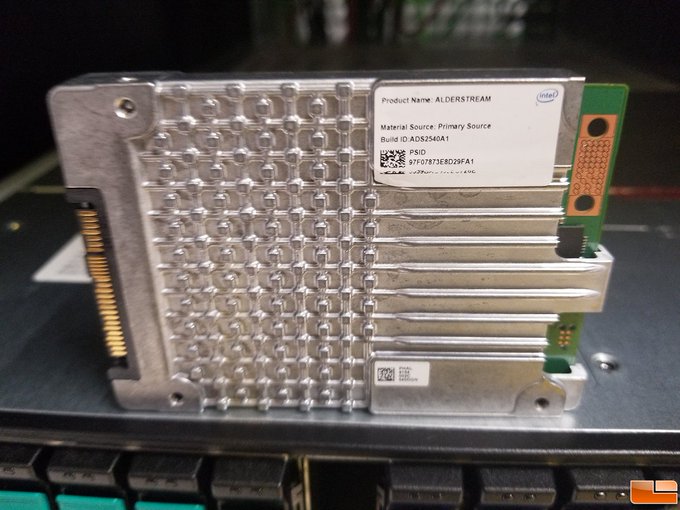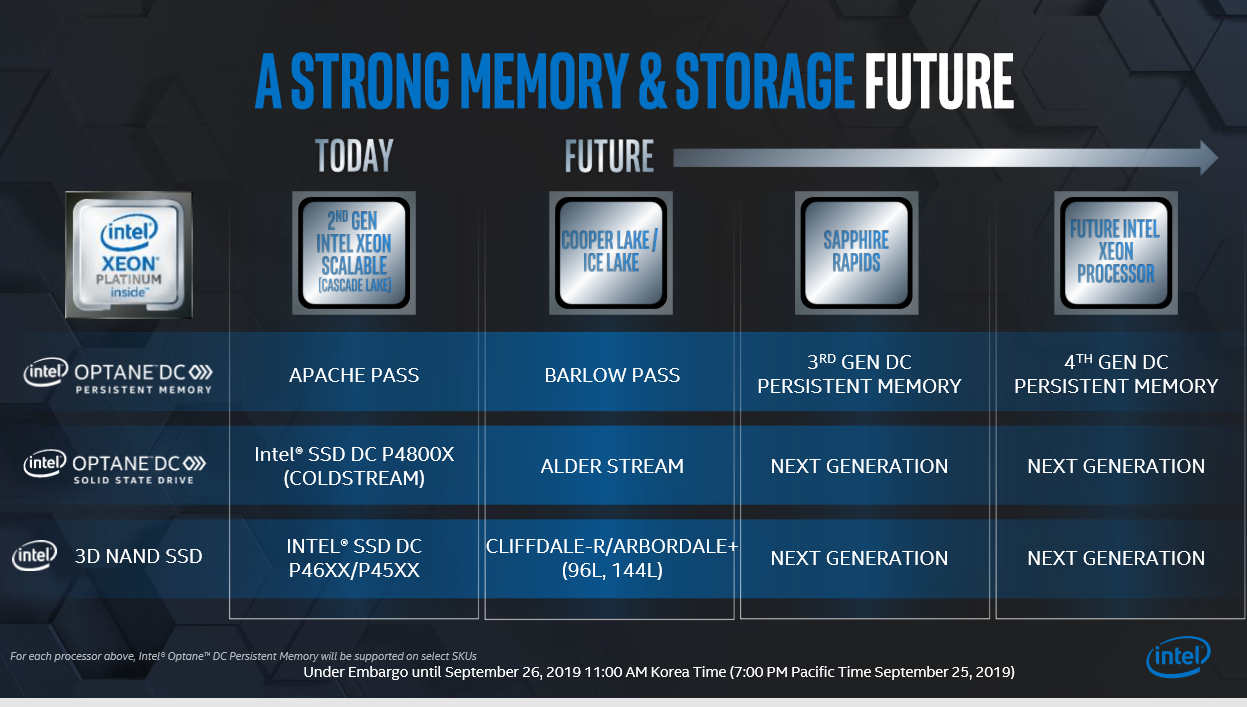Intel has PCIe 4.0 Optane SSDs Ready, But Nothing for Customers to Plug Them Into
Intel tipped its hand that PCIe 4.0 Optane SSDs are already sampling

In an interesting revelation that could give us some insight into how Intel's processor and storage roadmaps converge, even if forcibly, the company's Technical Marketing Performance Engineer Frank Ober recently posted to Twitter the unannounced information that the Alder Stream next-gen Optane SSDs would support the PCIe Gen 4.0 interface. From what we can glean from the posts, Ober has already sampled the drives to one Linux developer, meaning the drives are likely in the final stages of development, and is actively sampling the drives to others.
There's only one problem: Intel doesn't have any PCIe 4.0-capable CPUs available on the market for its customers to plug the drives into.
Intel teased us with its new Alder Stream second-gen Optane SSDs a few months ago but didn't share many details about the new drives. We do know the SSDs will come with second-gen Optane media (details here), which is an important step forward for Intel in the wake of its split with its ex-manufacturing partner Micron.
These initial Optane SSDs are destined for the data center, but this new revelation also gives us an indication of when we can expect to see new PCIe 4.0 Optane SSDs with second-gen 3D XPoint for the consumer market.



Given that Intel doesn’t have any processors (aside from the Stratix 10 FPGAs) that support the PCIe 4.0 interface, the developers obviously don't have access to an Intel-driven test platform with the new interface, so they could be testing with either AMD's EPYC Rome or Ryzen processors to use the new drives at their full potential. They could also connect them to Intel platforms with the PCIe 3.0 interface, which should still unlock extra performance from the next-gen SSDs controller and media.
Given that the drives appear nearly ready for market, that could present a conundrum for Intel as any current sales of its next-gen Optane products would only benefit its rivals (AMD chief among them) that do support the interface and the Optane drives through industry-standard protocols. Logically, that means the company might keep its next-gen Optane products off the market, even if they're ready, until it has processors that support the new faster interface.
According to Intel's latest statements to Tom's Hardware, the company plans to begin production of its PCIe 4.0-equipped 10nm Ice Lake processors in H2 2020, which means we might not see significant volume until several months later. In the interim, Intel will begin production of its 14nm Cooper Lake processors in the first half of 2020, and those chips almost certainly come with the PCIe 3.0 interface. As a result, it's logical to expect the company to launch the Alder Stream SSDs with the Ice Lake chips in the latter half of 2020 (provided it remains on schedule).
Get Tom's Hardware's best news and in-depth reviews, straight to your inbox.
If Intel follows its normal cadence, the consumer desktop SSDs in M.2 and PCIe add-in-card form factors should arrive shortly after the data center models, and that would slot into the expected timeline for Intel's PCIe 4.0-compatible desktop processors.
According to Intel's latest desktop announcements, Tiger Lake (rumored to have PCIe 4.0) lands in 2020, but those chips appear to be destined for the laptop market. Intel's first PCIe 4.0 chips for the desktop are thought to be Rocket Lake, which are rumored to arrive in early 2021.
AMD moved forward to PCIe 4.0 last year with the arrival of its EPYC and Ryzen processors for the data center and desktop markets, respectively, giving the company a big advantage in terms of I/O throughput.
Meanwhile, Intel has been mired on the PCIe 3.0 interface due to its next-gen architectures being locked behind its transition to the 10nm node. The company does plan to make future architectures portable between nodes, but for now, the company doesn’t have any PCIe 4.0-capable chips on the market, and barring any big unexpected announcements this week here at CES 2020, it doesn’t appear the company will support the interface until late 2020 or early 2021.
That’s because supporting PCIe 4.0 on a processor, at least in a meaningful way, isn’t just as simple as bolting on a PCIe 4.0 controller: The internal pathways have to be built to accommodate the increased throughput. There is the odd chance that Intel could support the PCIe 4.0 interface through external means only, such as only through devices connected to the chipset, but that doesn't seem likely.
In either case, Intel's Alder Stream second-gen Optane drives are apparently ready for sampling to partners, but due to the long qualification cycles in the enterprise, particularly when Intel is plowing ahead with a new media, it will likely be quite a while before the company launches the new drives. Regardless if the drives are ready or not, it's unlikely that Intel would release them before its own PCIe 4.0-capable processors are also ready for launch.

Paul Alcorn is the Editor-in-Chief for Tom's Hardware US. He also writes news and reviews on CPUs, storage, and enterprise hardware.
-
twotwotwo I get companies can try and fudge the reasons for their actions, but if it ends up clear Intel delayed an SSD or turned off features they'd built because they worked too well with others' hardware, isn't that the sort of thing that gets you sued for anticompetitive behavior? Maybe they fight it off, maybe not, but there's downside risk.Reply
They should just release the best SSD they can when it's ready, and if the timing means they have to get clever to get good PR, do what they have to. Maybe review samples come with conditions about what platform you test on, or if there's even an Intel-internal PCIe4 platform to test on you let the press mess with that.
PR difficulties are temporary, consent decrees are long-term. -
nofanneeded This means no PCIe 5.0 in the near future .... did Intel cancel it ? I thought it was coming in 2020 ?Reply -
TerryLaze Reply
Maybe they are releasing it because they already tested it on ryzen and it's still faster on intel with PCI3 than it is on ryzen with PCI4...the interface alone doesn't make things go any faster,you need a CPU that has enough cycles to get enough info off the disk.twotwotwo said:I get companies can try and fudge the reasons for their actions, but if it ends up clear Intel delayed an SSD or turned off features they'd built because they worked too well with others' hardware, isn't that the sort of thing that gets you sued for anticompetitive behavior?
Maybe it is faster on ryzen and intel will still release it because they main market for optane is optane RAM DIMMs and intel made the same amount of money from that in the last quarter that AMD made from all desktop CPU and GPU sales put together... -
JayNor Intel reported Ice Lake Server chips in the lab, booting linux, in Dec 2018. These have PCIE4. They may not be available to general public, but Intel samples their server chips to big customers long before general release.Reply
https://www.servethehome.com/first-pictures-of-intel-ice-lake-xeon-server-chips/
sampling Ice Lake Server since May, according to this
https://www.anandtech.com/show/14314/intel-xeon-update-ice-lake-and-cooper-lake-sampling
intel also shipping stratix 10dx with pcie4
https://www.tomshardware.com/news/intel-stratix-10-dx-upi-cxl,40436.html -
thGe17 Replynofanneeded said:This means no PCIe 5.0 in the near future .... did Intel cancel it ? I thought it was coming in 2020 ?
PCIe 5.0 has been announced with Sapphire Rapids SP for 1Q21 since 2Q19 with the updated roadmap (and the roadmap hasn't changed until now). The upcoming Whitley Platform (Cooper Lake & Ice Lake SP) will support up to PCIe 4.0 with Ice Lake, so maybe boards will be PCIe 4.0-ready in general (because otherwise I would have expected a different platform for Ice Lake SP CPUs with specific PCIe 4.0 support.).
Btw ... the point this article tries to make, feels like click bait. What's the problem? The SSDs are in their final development/validation stage but not released yet. They support PCIe 4.0 and will work well with for example IBM and AMD and will most likely also work with every 3.0-system in general (when they're officially launched any time soon). And in a few months, Intel will launch Ice Lake SP with native PCIe 4.0 support (and of course Intel can already test them together with Ice Lake SP in the lab).
It feels like everybody is searching and hoping for some kind of failure for a headline. Absolute nonsense. Should the team be forced to delay their development to be exactly on time to avoid to create a false appearance? :-x -
bit_user Reply
IIRC, an Intel server CPU with PCIe 5.0 is on their roadmap for 2021. They need it for CXL, which is how they plan on communicating with their datacenter GPUs and AI accelerators. So, I'm pretty sure it'll actually happen next year.nofanneeded said:This means no PCIe 5.0 in the near future .... did Intel cancel it ? I thought it was coming in 2020 ?
However, PCIe 5.0 won't be coming to desktops, in the foreseeable future. It's more expensive to implement, burns more power, and has tighter limitations on things like trace length. Beyond that, there's no need, as even PCIe 4.0 is currently borderline overkill, for desktops. -
bit_user Reply
Source?TerryLaze said:main market for optane is optane RAM DIMMs and intel made the same amount of money from that in the last quarter that AMD made from all desktop CPU and GPU sales put together... -
thGe17 ReplyTerryLaze said:and intel made the same amount of money from that in the last quarter that AMD made from all desktop CPU and GPU sales put together...
Not exactly but also not far-fetched either.
In 3Q19 AMD hat 1.80 B. US$ revenue over all and 1,27 B. revenue in the Computing and Graphics segment (consumer/mobile CPUs, chipsets and all GPUs, additionally some services and IP).
In 3Q19 Intel already had 1,3 B. revenue in the Non-Volatile Memory Solutions Group. (Additonally the IoT Group had 1.2 B revenue and their Client Computing Group had 9,7 B. revenue in 3Q19.) -
nofanneeded Replybit_user said:IIRC, an Intel server CPU with PCIe 5.0 is on their roadmap for 2021. They need it for CXL, which is how they plan on communicating with their datacenter GPUs and AI accelerators. So, I'm pretty sure it'll actually happen next year.
However, PCIe 5.0 won't be coming to desktops, in the foreseeable future. It's more expensive to implement, burns more power, and has tighter limitations on things like trace length. Beyond that, there's no need, as even PCIe 4.0 is currently borderline overkill, for desktops.
There is a huge need for PCIe 5.0 , we will not need 16 lnes anymore for GPU and this will open up more lanes for other cards ...
also I can see thunderbolt 5 with 4 lanes of PCIe 5.0 potential , an externa GPU with the same bandwidth of 16 lanes 3.0 today...
also docking stations for notebooks ... will be something huge. I know it will draw alot of power , but can be limitied to plugged power only and not batteries when docked only.